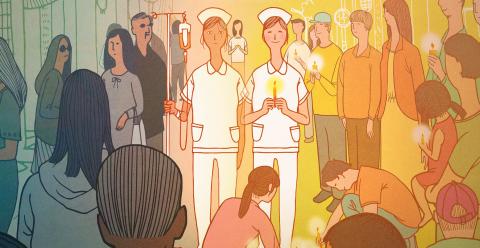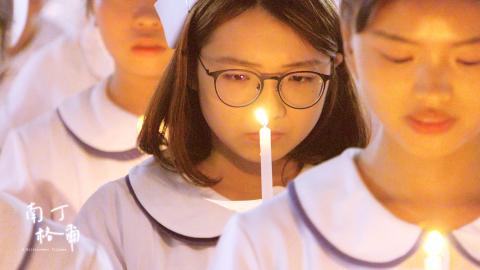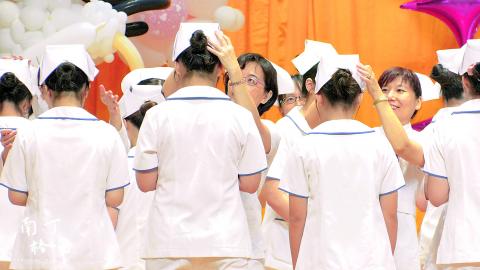In A Bittersweet Dilemma (南丁格爾), a man is seen screaming angrily at a nurse who has just told him she can’t change his father’s diapers because there’s another patient who needs critical care.
“We are paying customers! My father is human too,” he exclaims when the nurse suggests that a family member perform the task. When her supervisor appears, however, the nurse is found to be at fault.
While this scene is a simulation, documentary director Tim Yang (楊朝鈞) has seen his fair share of similar incidents since his days as an intern. The neurosurgeon at Chang Gung Hospital took up the camera three years ago to examine why Taiwan has a relatively high nurse-to-patient ratio, but A Bittersweet Dilemma grew into a multi-angled exploration of why only about 60 percent of certified nurses still work in the field. Many leave within five or six years for completely unrelated professions, he says.

Photo courtesy of Tim Yang
“Nurses aren’t respected,” Yang says. “If they were, the system wouldn’t be like this. People wouldn’t treat them this way. They spend just as much time training as doctors. It’s just the job description that’s different.”
“Taiwanese nurses are like nameless housewives and mothers, silently helping doctors serve patients,” says Yang Wan-ping (楊婉萍), assistant professor of nursing at Fooyin University (輔英大學). “Over time, people start taking their care for granted. If a patient recovers, credit goes to the doctors, the patient’s constitution and devoted family members. People forget that nurses take care of many details and provide considerable professional assistance.”
On Thursday last week, the documentary won an award of excellence at the Labor Gold Awards (勞動金像獎), hosted by the Taipei City Government’s Department of Labor. It was screened at the Taiwan International Labor Film Festival last month and Yang is looking for more opportunities to bring attention to the issue.

Photo courtesy of Tim Yang
TREATED AS SERVANTS
During his medical internship, Yang wanted to do something about the hardships he saw in the nursing industry. He was a photography enthusiast in college, and after taking a few classes in documentary filmmaking during his time off, he launched A Bittersweet Dilemma as a one-person project.
At first, Yang thought that the problems simply stemmed from the nurse-to-patient ratios in Taiwan, which result in long work hours with little time to even eat or use the restroom. Regulations passed in May of last year require a ratio of at least 1:9 for medical centers, 1:12 for regional hospitals and 1:15 for district hospitals. By comparison, the maximum ratio allowed in California is 1:5 depending on the assigned unit, while in September, a Florida intensive care unit nurse spoke out against her hospital’s 1:8 ratio to the New York Times.

Photo courtesy of Tim Yang
“With every patient over four assigned to one nurse in a medical surgical unit, there’s an increase in mortality of 7 percent per patient,” the article states.
But when Yang started interviewing nurses, he discovered a different problem.
“Some told me that they didn’t mind taking care of many patients as long as the patients treated them with respect. I soon realized that I wanted to focus on the relationship between nurses and patients,” Yang says.

Photo courtesy of Labor Gold Award
“There has already been plenty of coverage about the problems with the law and the system.”
In a restaurant, for example, customers are happy to be there and willing to spend money. The staff is hired specifically to serve their needs. But that isn’t the case for hospitals, Yang says, which can often lead to the kinds of conflicts he portrays in the film. In addition to the simulated scenes, several professionals address the issue as well.
“People now tend to see nurses as service workers instead of medical professionals,” says Cheng Hui-ju (鄭慧如), a supervisor at Fooyin University Hospital. “They’re not patients, they’re customers, and they demand the best service, often treating nurses as mere maids.”
“Our jobs are hectic. We have to perform a lot of professional tasks such as transfusing blood and injecting antibiotics. Tasks such as pouring water and changing diapers really aren’t part of our job. But people often press the emergency buttons to ask us to do those tasks,” former hospital room nurse Huang Mei-ying (黃玫罃) says.
A LITTLE RESPECT
Yang didn’t have big plans for the film at first. But after he showed it to friends and family, they seemed to become more appreciative and less demanding toward the nurses. This prompted him to enlist a crew and turn it into a professional product.
“The first cut I did on my own was so awful,” he laughs. “I couldn’t even finish watching it.”
Yang says that although nurse training can take up to seven years, and they’re the ones who spend the most time with the patients and understand their needs the best, they often looked down on by doctors.
“There’s little collaboration between nurses and doctors,” Yang says. “They’re expected to simply take orders. Also, sometimes the patients refuse to listen to anything the nurses say, but once the doctors appear, they quiet down.”
Yang believes that the Florence Nightingale ideal of self-sacrifice for humanity is outdated.
“They have to consider their own well-being too,” he says. “The labor conditions have improved a lot already, but the fact is that the retention rate is still low. And instead of creating a more favorable environment, the industry prefers to offer more classes and train more nurses to replace those who leave.”
Despite the stark reality, Yang says many nurses remain afraid to speak out, and even his father, who is a hospital administrator, opposed him releasing A Bittersweet Dilemma, asking him why he would want to make his employers look bad.
“I’m not exaggerating anything, nor am I focusing on one hospital in particular,” Yang says. “This is what I want to do, so I released it anyway.”
Would the film, which is trying to help more nurses stay in the industry, scare off potential nurses by so directly presenting the horrors of the job?
“That’s why I included some encouraging parts in the end,” Yang says. “I know many nurses who sincerely enjoy taking care of patients. It’s the environment that’s the issue.”

April 14 to April 20 In March 1947, Sising Katadrepan urged the government to drop the “high mountain people” (高山族) designation for Indigenous Taiwanese and refer to them as “Taiwan people” (台灣族). He considered the term derogatory, arguing that it made them sound like animals. The Taiwan Provincial Government agreed to stop using the term, stating that Indigenous Taiwanese suffered all sorts of discrimination and oppression under the Japanese and were forced to live in the mountains as outsiders to society. Now, under the new regime, they would be seen as equals, thus they should be henceforth

Last week, the the National Immigration Agency (NIA) told the legislature that more than 10,000 naturalized Taiwanese citizens from the People’s Republic of China (PRC) risked having their citizenship revoked if they failed to provide proof that they had renounced their Chinese household registration within the next three months. Renunciation is required under the Act Governing Relations Between the People of the Taiwan Area and the Mainland Area (臺灣地區與大陸地區人民關係條例), as amended in 2004, though it was only a legal requirement after 2000. Prior to that, it had been only an administrative requirement since the Nationality Act (國籍法) was established in

Three big changes have transformed the landscape of Taiwan’s local patronage factions: Increasing Democratic Progressive Party (DPP) involvement, rising new factions and the Chinese Nationalist Party’s (KMT) significantly weakened control. GREEN FACTIONS It is said that “south of the Zhuoshui River (濁水溪), there is no blue-green divide,” meaning that from Yunlin County south there is no difference between KMT and DPP politicians. This is not always true, but there is more than a grain of truth to it. Traditionally, DPP factions are viewed as national entities, with their primary function to secure plum positions in the party and government. This is not unusual

US President Donald Trump’s bid to take back control of the Panama Canal has put his counterpart Jose Raul Mulino in a difficult position and revived fears in the Central American country that US military bases will return. After Trump vowed to reclaim the interoceanic waterway from Chinese influence, US Defense Secretary Pete Hegseth signed an agreement with the Mulino administration last week for the US to deploy troops in areas adjacent to the canal. For more than two decades, after handing over control of the strategically vital waterway to Panama in 1999 and dismantling the bases that protected it, Washington has